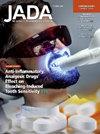同步远程牙科会诊对促进农村儿科患者遵从治疗的有效性。
IF 3.1
2区 医学
Q1 DENTISTRY, ORAL SURGERY & MEDICINE
引用次数: 0
摘要
背景:美国农村地区儿童口腔保健服务有限是一个严重的牙科公共卫生问题。2010 年,罗切斯特大学伊士曼口腔健康研究所启动了一项同步远程牙科项目,以加强对居住在纽约州西部地区的农村儿科患者的口腔健康检查、治疗计划和治疗完成情况:方法: 研究人员查阅了从 2010 年 4 月 13 日远程诊疗计划启动到 2022 年 12 月 31 日期间所有参与该计划的儿科患者的牙科记录数据。采用多元逻辑回归模型研究治疗达标率与年龄、性别、治疗方式以及 COVID-19 大流行的影响之间的关系:审查了 1,168 名儿童的牙科记录数据。九百五十四名儿童(81.6%)在同步远程会诊后的 6 个月内完成了建议的治疗。不同治疗方式的治疗完成率差异很大。诊室咨询的完成率最高(96.8%),其次是口服镇静剂(89.7%)和手术室治疗(89.5%)。一氧化二氮(66.7%)的使用率最低(P < .0001)。与其他治疗方式相比,被推荐使用氧化亚氮抗焦虑治疗的儿童完成治疗的几率最低(几率比,0.25;95% CI,0.18 至 0.36;P < .0001)。年龄越大,完成治疗的几率越小(几率比为 0.92;95% CI 为 0.85 至 0.99;P = .02)。COVID-19大流行对依从率没有明显影响:结论:与农村儿科患者及其监护人或看护人进行同步远程口腔诊疗可有效促进服务不足地区有复杂治疗需求的儿童完成治疗:同步远程门诊是牙科诊所应考虑采用的一种实用辅助工具。本文章由计算机程序翻译,如有差异,请以英文原文为准。
Effectiveness of synchronous teledentistry consultations in facilitating treatment compliance of rural pediatric patients
Background
Limited access to pediatric oral health care in rural US areas is a substantial dental public health problem. In 2010, the Eastman Institute for Oral Health at the University of Rochester, initiated a synchronous teledentistry program to enhance oral health screenings, treatment planning, and treatment completion for rural pediatric patients who reside in the Western region of New York.
Methods
Data from dental records of all pediatric patients who were participants in the teledentistry program from its inception on April 13, 2010 through December 31, 2022, were reviewed. Multiple logistic regression models were used to study the association between treatment compliance rate and age, sex, treatment modality, and impact of the COVID-19 pandemic.
Results
Data from the dental records of 1,168 children were reviewed. Nine hundred fifty-four children (81.6%) completed the recommended treatment within 6 months of synchronous teledentistry consultation. Treatment completion rates varied significantly according to treatment modality. In-office consultation had the highest rate (96.8%), followed by oral sedation (89.7%) and operating room treatment (89.5%). Nitrous oxide (66.7%) had the lowest rate (P < .0001). Children recommended for nitrous oxide anxiolysis had the lowest odds of completing treatment (odds ratio, 0.25; 95% CI, 0.18 to 0.36; P < .0001) compared with other treatment modalities. Being older decreased the likelihood of completing treatment (odds ratio, 0.92; 95% CI, 0.85 to 0.99; P = .02). The COVID-19 pandemic did not significantly affect compliance rates.
Conclusions
Synchronous teledentistry consultations with rural pediatric patients and their guardians or caregivers can effectively facilitate treatment completion for children with complex treatment needs in underserved areas.
Practical Implications
Synchronous teledentistry is a practical adjunct tool to be considered in dental offices.
求助全文
通过发布文献求助,成功后即可免费获取论文全文。
去求助
来源期刊

Journal of the American Dental Association
医学-牙科与口腔外科
CiteScore
5.30
自引率
10.30%
发文量
221
审稿时长
34 days
期刊介绍:
There is not a single source or solution to help dentists in their quest for lifelong learning, improving dental practice, and dental well-being. JADA+, along with The Journal of the American Dental Association, is striving to do just that, bringing together practical content covering dentistry topics and procedures to help dentists—both general dentists and specialists—provide better patient care and improve oral health and well-being. This is a work in progress; as we add more content, covering more topics of interest, it will continue to expand, becoming an ever-more essential source of oral health knowledge.
 求助内容:
求助内容: 应助结果提醒方式:
应助结果提醒方式:


